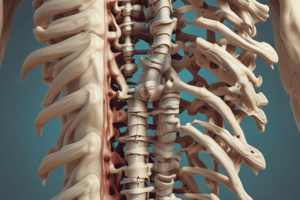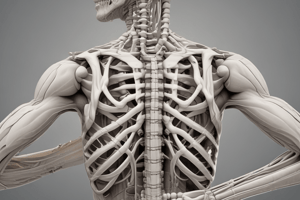Podcast
Questions and Answers
What is kyphosis primarily characterized by?
What is kyphosis primarily characterized by?
- An exaggeration of anterior thoracic curvature
- An exaggeration of posterior thoracic curvature (correct)
- An increase in lumbar spinal curvature
- A lack of spinal curvature
In which part of the spine are kyphotic curves most commonly found?
In which part of the spine are kyphotic curves most commonly found?
- Lumbar spine
- Cervical spine
- Thoracic or thoracolumbar spine (correct)
- Sacral spine
Which term describes a severe form of kyphosis?
Which term describes a severe form of kyphosis?
- Lordosis
- Scoliosis
- Hyperkyphosis (correct)
- Hypokyphosis
What is a common visual description for individuals with kyphosis?
What is a common visual description for individuals with kyphosis?
What might diagrams of spinal curvatures be used for?
What might diagrams of spinal curvatures be used for?
What is a primary indication for surgical intervention in postural kyphosis management?
What is a primary indication for surgical intervention in postural kyphosis management?
Which of the following is NOT recommended as part of the management for postural kyphosis?
Which of the following is NOT recommended as part of the management for postural kyphosis?
What are common symptoms that may warrant surgical intervention for kyphosis?
What are common symptoms that may warrant surgical intervention for kyphosis?
Which component is part of the instrumentation used for surgical procedures in spinal deformity correction?
Which component is part of the instrumentation used for surgical procedures in spinal deformity correction?
In managing postural kyphosis, what is the purpose of physical therapy?
In managing postural kyphosis, what is the purpose of physical therapy?
Flashcards
Kyphosis Definition
Kyphosis Definition
Excessive posterior curvature of the thoracic spine, often appearing as a "humpback" or "hunchback".
Kyphosis Location
Kyphosis Location
Commonly found in the thoracic or thoracolumbar spine, but can also occur in the cervical area.
Kyphosis Types
Kyphosis Types
Kyphosis can be hyperkyphosis (increased curve) or gibbus (sharp angular curve).
Kyphosis Spine Region
Kyphosis Spine Region
Signup and view all the flashcards
Kyphosis Progression
Kyphosis Progression
Signup and view all the flashcards
Postural Kyphosis Treatment
Postural Kyphosis Treatment
Signup and view all the flashcards
Surgical Indication (Kyphosis)
Surgical Indication (Kyphosis)
Signup and view all the flashcards
Surgical Instrumentation
Surgical Instrumentation
Signup and view all the flashcards
Scheuermann's Kyphosis Threshold
Scheuermann's Kyphosis Threshold
Signup and view all the flashcards
Conservative Kyphosis Treatment
Conservative Kyphosis Treatment
Signup and view all the flashcards





